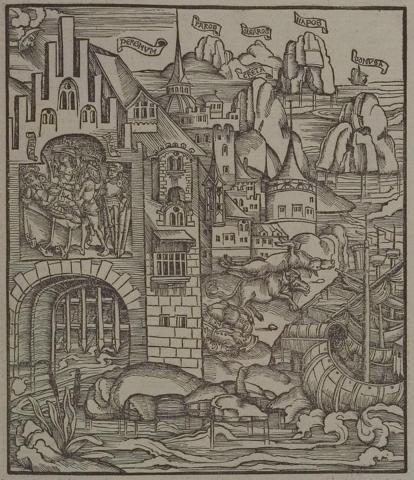Annotations
The scene is set in Crete, where Aeneas and his people have founded a city, Pergamum (132-4). In the background to the right are Paros, Olearos, Napos and Donysa, islands of the Cyclades, which Aeneid passed by on his journey from Thrace to Crete (121-7). On the left, Aeneas, asleep in his bed, is surrounded by the images of Pallas, Mercury, and Jupiter, in place of the Penates, who appear to Aeneas as he sleeps (147-53). Outside the house of Aeneas, people and animals lie dead from a terrible pestilence that has killed many of Aeneas's people and many of the crops (135-42). In the upper left corner, the moon valiantly shines down on the house of Aeneas, as mentioned by Vergil (151-2). The ships in the right foreground signify both the recent arrival of the people and their imminent departure. (Katy Purington)
Woodcut illustration from the “Strasbourg Vergil,” edited by Sebastian Brant: Publii Virgilii Maronis Opera cum quinque vulgatis commentariis expolitissimisque figuris atque imaginibus nuper per Sebastianum Brant superadditis (Strasbourg: Johannis Grieninger, 1502), fol. 190r, executed by an anonymous engraver under the direction of Brant.


Sebastian Brant (1458–1521) was a humanist scholar of many competencies. Trained in classics and law at the University of Basel, Brant later lectured in jurisprudence there and practiced law in his native city of Strasbourg. While his satirical poem Das Narrenschiff won him considerable standing as a writer, his role in the transmission of Virgil to the Renaissance was at least as important. In 1502 he and Strasbourg printer Johannes Grüninger produced a major edition of Virgil’s works, along with Donatus’ Life and the commentaries of Servius, Landino, and Calderini, with more than two hundred woodcut illustrations. (Annabel Patterson)